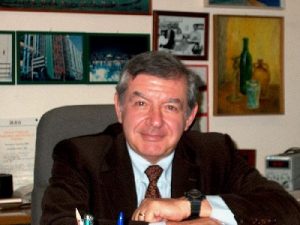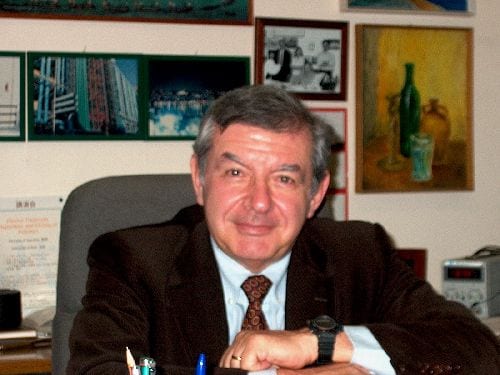 The first issue including the new debate section on plasma kinetics has just been published in Plasma Processes and Polymers. One of the Editors-in Chief of the journal, Prof. Riccardo d`Agostino from the University of Bari, Italy, an expert in low-pressure plasma processes and diagnostics for the modification of materials and explains us what is new and why it is so special.
The first issue including the new debate section on plasma kinetics has just been published in Plasma Processes and Polymers. One of the Editors-in Chief of the journal, Prof. Riccardo d`Agostino from the University of Bari, Italy, an expert in low-pressure plasma processes and diagnostics for the modification of materials and explains us what is new and why it is so special.
CT: Prof. d´Agostino, you initiated the publication of the new debate section in our journal Plasma Processes and Polymers. Can you explain how this idea came about?
RdA: With this initiative we want to be the first that give our readers the opportunity of comparing their own ideas and theories in a rigorous and open way. By doing this they will contribute to make their journal alive. This debate is dealing with important hot topics such as the ones we have chosen to start with.
CT: Why is the topic macroscopic kinetics so contentious?
RdA: I think it was the time to start the discussion because there are sometimes different opinions on whether macroscopic kinetics of polymerization is an useful and comprehensive treatment. Certainly the main advantage is that it is a way to make a thoughtful description of a process allowing to collect different experiments and regimes of polymerization under a single overall kinetic expression. Obviously, the overall kinetics are a macroscopic not a microscopic description. This means that, while this treatment is not made for expressing the real microscopic kinetics, there is certainly a need for an overall macroscopic description to make comparisons between different laboratories and for finding scaling up criteria of reactors and processes for industrial applications. And for sure we know that in other journals a discussion on this kind of macroscopic kinetics in polymerization is almost completely ignored. So I think it is a good input for the future.
CT: Why do you think there is a need to make this debate public?
RdA: I think plasma polymerization is a very important issue. It is actually a unique tool that scientists can use to modify materials by modifying the surfaces. We can avoid thinking of new materials, you can simply use old materials with the new surfaces. Covering the surface with nanostructured polymers, you can make your macroscopic old material enter into the same magnificent world of the nanomaterials, with their unique properties. This opens the field to a huge spectrum of applications, you can for example think of anti-friction or anti-fog surfaces, self-cleaning surfaces or of materials for cell culturing and tissue engineering and many other possible applications.
CT: Traditionally, you can write a commentary to give your opinion on a paper. So how is this new debate section different?
RdA: The difference is that we make the journal a live tool in the hands of the readers, without losing the scientific rigour. The readers choose the important issues of the debate to discuss. I think that will be the big difference. Not like a comment on a paper in which somebody disagrees on different results, I mean, this is a more important confrontation of ideas, theories, methods and so on.
CT: With the publication of this debate you want to invite other readers to participate in this discussion. What do you expect? Will people follow the discussion?
RdA: Yes, I think so. I am confident and maybe it will take some time, but the readers will react and will realize that there is a journal here that is more alive, that deals with the issues which are important for their everyday work. Here they can say their opinion, and the debate issue will become more and more important. This is unique in our journal as no other has it. So hopefully people will participate and promote the journal.
CT: Scientists usually discuss their issues in a more personal way, for example, at conferences and possibly not everybody wants to express criticism in public. Do you have any concerns about that?
RdA: Yes, in fact. Actually, we had this idea for the first time at the PSE conference. I was attending an invited lecture by Dirk Hegemann and he was skilfully speaking about overall macroscopic kinetics. The presentation was very interesting and I found it an interesting issue for a debate. Actually I started to debate there at the PSE, but this procedure, although is important, has however a limited feedback. Then I thought that it would be very useful to transfer it to the journal, because you have the time to think more deeply the arguments through and to make a better discussion. It is a more detailed discussion and a wide comparison of ideas from different authors. Then the spark was an article of Hegemann et al. on “Plasma polymerization of Acrylic Acid – revisited” and a commentary article of R.D. Short et al. The occasion was perfect for starting these debates!
CT: In this context, how do you intend to judge the quality of the contributions? How are the contributions reviewed?
RA: To begin with, the articles of the commentators are invited. We have chosen among the people who are very competent in the field, but this is only a first approach, and is followed by an invitation to all the readers to participate the discussion. This point of extention of the discussion is important. We have started the discussion, but the discussion has to be carried on by the readers. All contributions are reviewed with the usual critical approach to ensure high quality.
CT: How can our interested readers contribute with their opinion?
RdA: They can just send their own short papers concerning the arguments of the debate. They will be evaluated through peer reviewing criteria of our journal as usual. So they can regard the debate paper as a regular contribution and in no case second class papers. They are real scientific works and we are looking forward to receiving them!
CT: Are there further topics that need to be discussed?
RdA: We have in mind to open another discussion or debate on a CAG – contact angle goniometry, upon suggestion of Michel Wertheimer. Actually, we have received an extremely interesting and provocative article from Mark Stroebel and co-workers and we have found this is an important issue too often ignored by scientists contributing. For this reason we have accepted this debate and we have already asked different institutions to participate. I am pretty sure we will have a very bright discussion with their comments and arguments, which will open a floodgate to an argument of enormous importance for materials, even independently for the fact the materials are made by plasma or other tools.
CT: In your role as Editor-in-Chief for Plasma Processes and Polymers you have been supporting and developing the journal for many years now. What does this new format mean for the journal?
RdA: This new format will make the difference from the others. We are at the very beginning so I do not know how it will change the journal, but I have the impression we are laying the foundations for making innovative scientific journals. This will turn to be a sort of revolution for this kind of journals and a great opportunity.
CT: Do you think this could be a trend for research in general for other topics and journals?
RdA: Yes, absolutely, I think it will be exported to journals dealing with other issues. What is important is the method, not the particular argument.
CT: To conclude, what are your expectations and hopes for the new section?
RA: My expectation is that the readership will increase because the people will feel
the journal is more produced by them. They will react by sending their articles and will feel the journal is their own creation, because they have the chance to change the journal according to their ideas. This is an extremely creative moment in the journal´s life, which will hopefully make a very positive big difference.

















